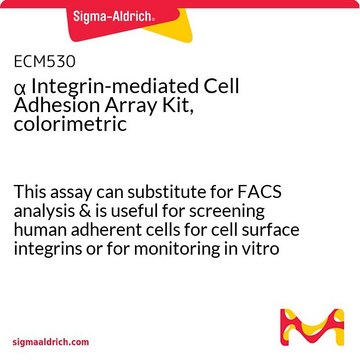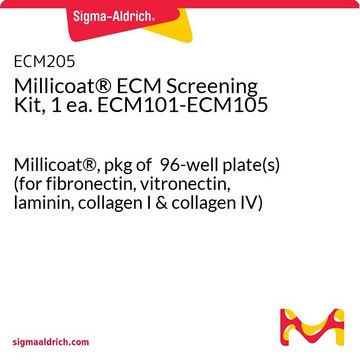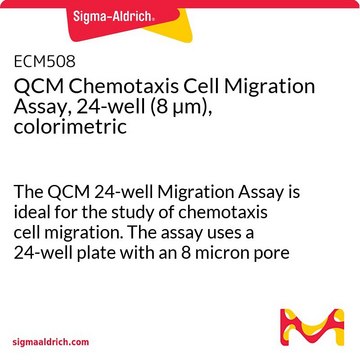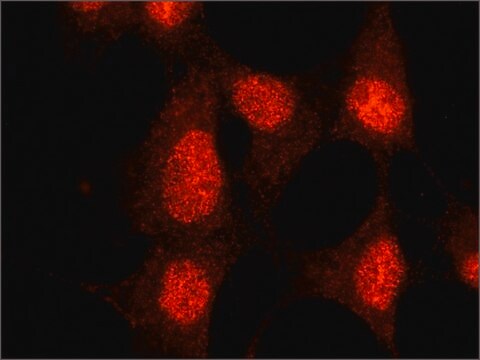ECM540
ECM Cell Adhesion Array Kit, colorimetric
The ECM Cell Adhesion Array kit is useful for assessing specific cell surface integrins, monitoring in vitro cell differentiation, or screening potential cell adhesion promoters/inhibitors.
Sinonimo/i:
Extracellular matrix array cell adhesion assay
Autenticatiper visualizzare i prezzi riservati alla tua organizzazione & contrattuali
About This Item
Codice UNSPSC:
12352207
eCl@ss:
32161000
NACRES:
NA.32
Prodotti consigliati
Livello qualitativo
Reattività contro le specie
human
Produttore/marchio commerciale
Chemicon®
tecniche
cell based assay: suitable
Metodo di rivelazione
colorimetric
Condizioni di spedizione
wet ice
Descrizione generale
Introduction:
Cell adhesion plays a major role in cellular communication and regulation, and is of fundamental importance in the development and maintenance of tissues. Scientists are continually examining the adhesion, migration, and invasion of many diverse cell types on various extracellular matrix (ECM) component proteins. The CHEMICON ECM Cell Adhesion Array Kit (Colorimetric) provides an ECM Array microtiter plate with a colorimetric detection format, allowing for large-scale screening and quantitative comparison of multiple samples/cell lines. The kit is designed as a rapid (1-2 hours), cost effective, efficient method for characterization of cell adhesion.
In addition, Chemicon continues to provide numerous migration, invasion, and adhesion products including:
· Alpha Integrin-Mediated Cell Adhesion Array Kit (Colorimetric) (ECM530)
· Beta Integrin-Mediated Cell Adhesion Array Kit (Colorimetric) (ECM531)
· Alpha/Beta Integrin-Mediated Cell Adhesion Array Combo Kit (Colorimetric) (ECM532)
· Alpha Integrin-Mediated Cell Adhesion Array Kit (Fluorimetric) (ECM533)
· Beta Integrin-Mediated Cell Adhesion Array Kit (Fluorimetric) (ECM534)
· Alpha/Beta Integrin-Mediated Cell Adhesion Array Combo Kit (Fluorimetric) (ECM535)
· ECM Cell Adhesion Array Kit (Fluorimetric) (ECM545)
· QCM 8μm 96-well Chemotaxis Cell Migration Assay (ECM510)
· QCM 5μm 96-well Chemotaxis Cell Migration Assay (ECM512)
· QCM 3μm 96-well Chemotaxis Cell Migration Assay (ECM515)
· QCM 96-well Cell Invasion Assay (ECM555)
· QCM 96-well Collagen-Based Cell Invasion Assay (ECM 556)
· 24-well Insert Cell Migration and Invasion assay systems
· CytoMatrix Cell Adhesion strips (ECM protein coated)
· QuantiMatrix ECM protein ELISA kits
Test Principle:
The CHEMICON ECM Cell Adhesion Array kit utilizes a colorimetric detection format, allowing large-scale screening and quantitative comparison of multiple samples. Each kit contains a 96-well, microtiter plate consisting of 12 X 8-well removable strips. Each well within a strip (7 wells total) is pre-coated with a different ECM protein (see table below) along with one BSA-coated well (negative control). Experimental cells are seeded onto the coated substrates, where adherent cells are captured. Subsequently, unbound cells are washed away, and the adherent cells are fixed and stained. After stain extraction, the relative cell attachment is determined using absorbance readings.
Additional information about the ECM components provided in the kit:
Cell adhesion plays a major role in cellular communication and regulation, and is of fundamental importance in the development and maintenance of tissues. Scientists are continually examining the adhesion, migration, and invasion of many diverse cell types on various extracellular matrix (ECM) component proteins. The CHEMICON ECM Cell Adhesion Array Kit (Colorimetric) provides an ECM Array microtiter plate with a colorimetric detection format, allowing for large-scale screening and quantitative comparison of multiple samples/cell lines. The kit is designed as a rapid (1-2 hours), cost effective, efficient method for characterization of cell adhesion.
In addition, Chemicon continues to provide numerous migration, invasion, and adhesion products including:
· Alpha Integrin-Mediated Cell Adhesion Array Kit (Colorimetric) (ECM530)
· Beta Integrin-Mediated Cell Adhesion Array Kit (Colorimetric) (ECM531)
· Alpha/Beta Integrin-Mediated Cell Adhesion Array Combo Kit (Colorimetric) (ECM532)
· Alpha Integrin-Mediated Cell Adhesion Array Kit (Fluorimetric) (ECM533)
· Beta Integrin-Mediated Cell Adhesion Array Kit (Fluorimetric) (ECM534)
· Alpha/Beta Integrin-Mediated Cell Adhesion Array Combo Kit (Fluorimetric) (ECM535)
· ECM Cell Adhesion Array Kit (Fluorimetric) (ECM545)
· QCM 8μm 96-well Chemotaxis Cell Migration Assay (ECM510)
· QCM 5μm 96-well Chemotaxis Cell Migration Assay (ECM512)
· QCM 3μm 96-well Chemotaxis Cell Migration Assay (ECM515)
· QCM 96-well Cell Invasion Assay (ECM555)
· QCM 96-well Collagen-Based Cell Invasion Assay (ECM 556)
· 24-well Insert Cell Migration and Invasion assay systems
· CytoMatrix Cell Adhesion strips (ECM protein coated)
· QuantiMatrix ECM protein ELISA kits
Test Principle:
The CHEMICON ECM Cell Adhesion Array kit utilizes a colorimetric detection format, allowing large-scale screening and quantitative comparison of multiple samples. Each kit contains a 96-well, microtiter plate consisting of 12 X 8-well removable strips. Each well within a strip (7 wells total) is pre-coated with a different ECM protein (see table below) along with one BSA-coated well (negative control). Experimental cells are seeded onto the coated substrates, where adherent cells are captured. Subsequently, unbound cells are washed away, and the adherent cells are fixed and stained. After stain extraction, the relative cell attachment is determined using absorbance readings.
Additional information about the ECM components provided in the kit:
Applicazioni
Research Category
Cell Structure
Cell Structure
The CHEMICON ECM Cell Adhesion Array kit is useful for assessing specific cell surface integrins, monitoring in vitro cell differentiation, or screening potential cell adhesion promoters/inhibitors.
For Research Use Only. Not for use in diagnostic procedures.
For Research Use Only. Not for use in diagnostic procedures.
Confezionamento
96 wells
Componenti
ECM Array Plate: (PN: 90652) One 96-well plate with 12 strips. Each 8-well strip consists of 7 different human, ECM protein-coated wells (Collagen I, Collagen II, Collagen IV, Fibronectin, Laminin, Tenascin, Vitronectin) and one BSA-coated well (negative control). See the plate layout on Data sheet.
Cell Stain Solution: (Part No. 90144) One bottle - 20 mL.
Extraction Buffer: (Part No. 90145) One bottle - 20 mL.
Assay Buffer: (Part No. 90601) One bottle - 100 mL.
Cell Stain Solution: (Part No. 90144) One bottle - 20 mL.
Extraction Buffer: (Part No. 90145) One bottle - 20 mL.
Assay Buffer: (Part No. 90601) One bottle - 100 mL.
Stoccaggio e stabilità
The ECM Array Plate can be stored at 2° to 8°C in the foil pouch up to its expiration date. Unused strips may be placed back in the pouch for storage. Ensure that the desiccant remains in the pouch, and that the pouch is securely closed. Keep the remaining kit components at 2° to 8°C.
Precautions:
· Cell stain contains minor amounts of crystal violet, a toxic substance, which may cause cancer and heritable genetic damage. Handle with caution. Toxic by inhalation and if swallowed. Irritating to eyes, respiratory system and skin.
· Extraction buffer contains alcohol. Avoid internal consumption.
Precautions:
· Cell stain contains minor amounts of crystal violet, a toxic substance, which may cause cancer and heritable genetic damage. Handle with caution. Toxic by inhalation and if swallowed. Irritating to eyes, respiratory system and skin.
· Extraction buffer contains alcohol. Avoid internal consumption.
Note legali
CHEMICON is a registered trademark of Merck KGaA, Darmstadt, Germany
Esclusione di responsabilità
Unless otherwise stated in our catalog or other company documentation accompanying the product(s), our products are intended for research use only and are not to be used for any other purpose, which includes but is not limited to, unauthorized commercial uses, in vitro diagnostic uses, ex vivo or in vivo therapeutic uses or any type of consumption or application to humans or animals.
Avvertenze
Danger
Indicazioni di pericolo
Consigli di prudenza
Classi di pericolo
Eye Irrit. 2 - Flam. Liq. 2
Codice della classe di stoccaggio
3 - Flammable liquids
Punto d’infiammabilità (°F)
53.6 °F
Punto d’infiammabilità (°C)
12 °C
Certificati d'analisi (COA)
Cerca il Certificati d'analisi (COA) digitando il numero di lotto/batch corrispondente. I numeri di lotto o di batch sono stampati sull'etichetta dei prodotti dopo la parola ‘Lotto’ o ‘Batch’.
Possiedi già questo prodotto?
I documenti relativi ai prodotti acquistati recentemente sono disponibili nell’Archivio dei documenti.
I clienti hanno visto anche
Srikanth Appikonda et al.
The Journal of biological chemistry, 293(19), 7476-7485 (2018-03-11)
Proteins with domains that recognize and bind post-translational modifications (PTMs) of histones are collectively termed epigenetic readers. Numerous interactions between specific reader protein domains and histone PTMs and their regulatory outcomes have been reported, but little is known about how
Zhao Jingjing et al.
Naunyn-Schmiedeberg's archives of pharmacology, 393(8), 1549-1558 (2020-01-05)
Diffuse large B-cell lymphoma (DLBCL) is the most aggressive non-Hodgkin lymphoma (NHL), accounting for about 31% of the newly diagnosed NHL worldwide. Although approximately 60% of patients who initially received a standard R-CHOP treatment likely have a 3-year event-free survival
Xiaomu Wei et al.
Human mutation, 32(6), E2148-E2175 (2011-05-28)
We performed a mutational analysis of the 19 disintegrin-metalloproteinases (ADAMs) genes in human cutaneous metastatic melanoma and identified eight to be somatically mutated in 79 samples, affecting 34% of the melanoma tumors analyzed. Functional analysis of the two frequently mutated
Lindsay M LaFave et al.
Cancer cell, 38(2), 212-228 (2020-07-25)
Regulatory networks that maintain functional, differentiated cell states are often dysregulated in tumor development. Here, we use single-cell epigenomics to profile chromatin state transitions in a mouse model of lung adenocarcinoma (LUAD). We identify an epigenomic continuum representing loss of
Il team dei nostri ricercatori vanta grande esperienza in tutte le aree della ricerca quali Life Science, scienza dei materiali, sintesi chimica, cromatografia, discipline analitiche, ecc..
Contatta l'Assistenza Tecnica.










